This 8×10 canvas stretching tutorial focuses on a giclee print on canvas. However, the steps can also be applied to any small-sized canvas, whether raw, primed, or painted. I provide tutorials like this for free because I feel that all of us should be able to enjoy creating art without all the extra “costs” that many would charge for this level of information.
8×10 Canvas Stretching – Materials and Tools
Step 1
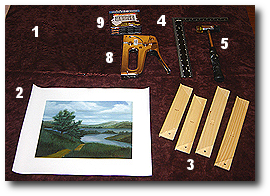
Before starting, Assemble all materials and tools for the 8×10 canvas stretching tutorial.
- Cloth Work Surface
- Giclee Print
- Pre-Made Stretcher Bars
- Square Ruler
- Mallet
- Small Hammer (not shown)
- Flathead Screwdriver (not shown)
- Staple Gun
- 1/4″ Staples
Canvas Stretching – Assemble the Stretcher Bars
Step 2
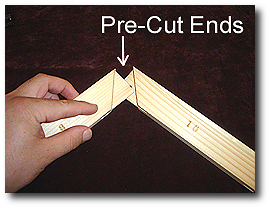
In this example, we used pre-made stretcher bars that come ready to assemble. These stretcher bars have cut grooves at each end for mating and interlocking to adjacent bars. You may need to sand rough edges on pre-made stretchers because the cutting tools used during manufacturing may leave wood burrs and sharp edges.
Step 3
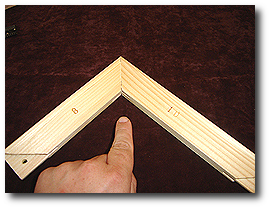
Make sure that you fully seat the two stretcher bar ends. You must still mate the two bars fully if you see a gap along the seam where the ends meet.
Step 4
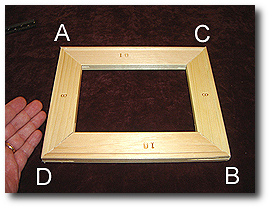
In this view, see all four stretcher bars mated together. However, we must ensure that all four corners of this assembly are square. (i.e., A, B, C, & D)
Step 5
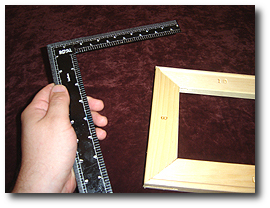
We must check each corner using a square ruler to ensure they are square. It is a critical step because if your final assembly is not square, it may not fit into your frame.
Step 6

Hold the square ruler as shown and check that both inside edges of the ruler run flush along the surface of each stretcher bar. If the ruler lifts off one side (not running flush along one surface while being thoroughly flush on the other), you are not square on that corner.
Step 7
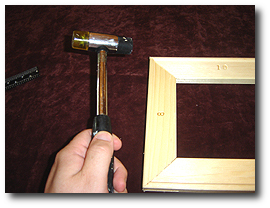
Using a mallet, gently tap the corner(s) to make adjustments.
Step 8
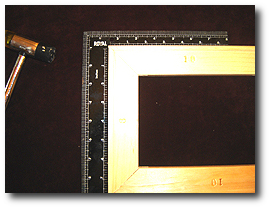
Recheck corners until they are all square. Now you are ready to start the canvas mounting process.
Canvas Stretching – Prepare for Stapling
Step 9
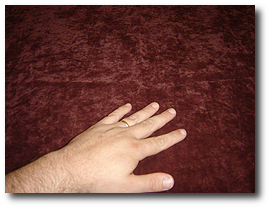
Before laying down your giclee canvas print, make sure there are no debris or wood pieces (that may have fallen off during stretcher bar assembly) that could damage the printed surface. Use a soft cloth work surface to minimize the chances of causing minor scratches to your giclee canvas print.
Step 10
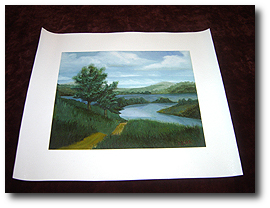
Lay down your print (face up) and make a final close examination to ensure there is no damage from the print supplier.
Step 11
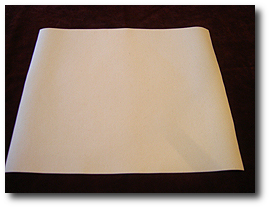
At this point, turn over your giclee print so that the image is face down. You are now ready to position your stretcher bar assembly.
Step 12
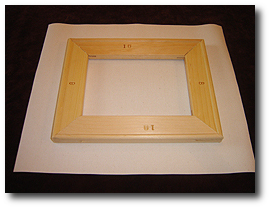
Place your stretcher bar assembly over your giclee canvas print as shown.
Step 13
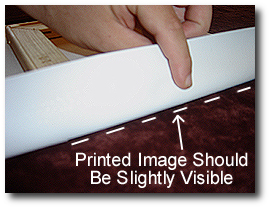
Starting with the right side, carefully lift the canvas print and ensure that the image wraps around the front face of the stretcher bar. Repeat this on the opposite side, moving the stretcher assembly left or right until you see the image wrapping equally around both sidebars.
Step 14
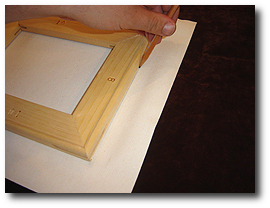
Once you have centered the stretcher bar about the printed image, draw a reference line along each side as shown. This reference line will be helpful later if the stretcher assembly moves out of position and you need to realign it.
Step 15

As we did in Step 13 for the side positioning, we want to center the stretcher bar assembly along the top and bottom bars. Carefully lift the canvas print and ensure that the image wraps around the front face of the bottom stretcher bar. Repeat this for the top stretcher bar, moving the stretcher assembly up or down as needed until you see the image wrapping equally around the top and bottom bars.
Step 16
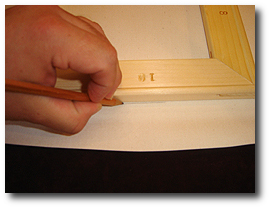
Once you have centered the stretcher bar about the printed image, draw a reference line along each side as shown. The stretcher bar assembly is now centered in the printed image’s vertical and horizontal directions. We are ready to begin the canvas stretching, wrapping, and stapling processes.
8×10 Canvas Stretching – Stretching and Installing First Staples
Step 17
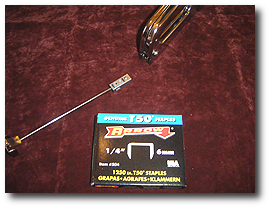
For this example, we have selected 1/4″ staples. Load your staple gun, so you stay supplied with staples partway through the following steps.
Step 18
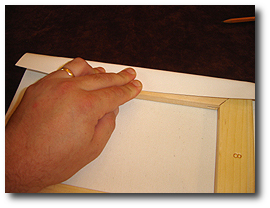
Starting with the top stretcher bar, wrap the giclee canvas print around the stretcher bar as shown. Ensure the stretcher assembly has stayed in the reference lines we drew earlier.
Step 19

Holding the staple gun squarely on the canvas and stretcher bar, staple the canvas to the stretcher bar in the center of the bar as shown.
Step 20

Check that your assembly looks like this – having one staple in the center of the top stretcher bar.
Step 21
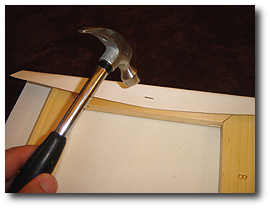
Sometimes the staple gun is not held square to the canvas and stretcher bar resulting in a partially inserted staple. Lightly tap the staple with a hammer until fully inserted.
Step 22
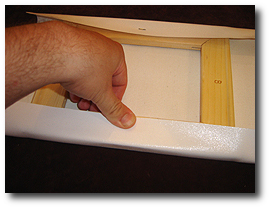
We are now ready to tightly pull and wrap the giclee canvas print around the bottom stretcher bar. Using your hand strength, stretch the canvas, wrap it around the bottom stretcher bar, and hold it securely with your thumb (as shown) in preparation for stapling.
Step 23
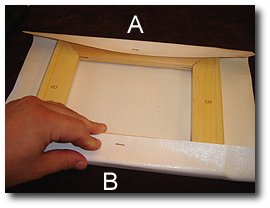
While holding your thumb in place, insert one staple in the center of the bottom stretcher bar. Once you have added the first two staples into the top and bottom stretcher bars, you should notice a slight tension pull on the canvas between the two staple points (i.e., points A and B.)
Step 24
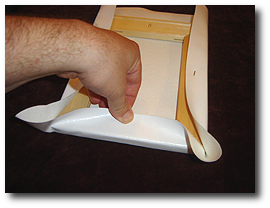
As we did in the previous steps for the top and bottom, now we must secure the left and right sides. Starting with the left side, stretch, wrap, and hold the canvas securely in preparation for stapling. (Not shown: Insert one staple in the center of the left stretcher bar.)
Step 25
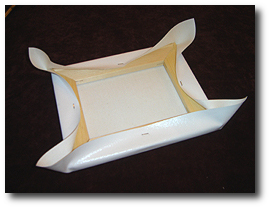
As we did in the previous steps, stretch, wrap, and staple the right side. When stapling opposing sides, you pull the canvas, so it does not droop or sag. Our assembly should now have one staple placed directly in the center of each stretcher bar, as shown.
Step 26
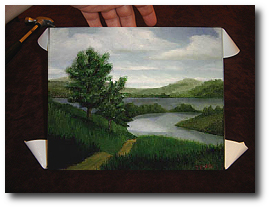
Flip over the assembly, so you look at the printed image on the front. Check that the image is centered vertically and horizontally – you should see the image wrapping equally around all sides, and no ‘white’ border should be visible along the front face. Check that the image has not rotated clockwise or counter-clockwise so that it is no longer square with the stretcher bars.
Also, check that the printed image is tight enough and sagging. In the following steps, we will tighten the canvas as we stretch, wrap, and insert the remaining staples, but now is the time to remove the staples and make adjustments if the position of the image is off or the canvas is very loose and sagging.
8×10 Canvas Stretching – Stretching and Install Remaining Staples
Step 27
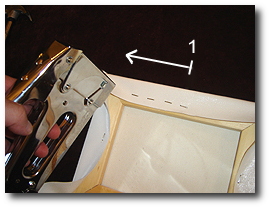
Beginning with the top stretcher bar (1), insert staples starting from the center staple and moving left with each new staple until you reach the left stretcher bar as shown.
Step 28
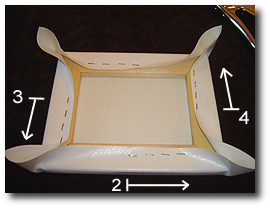
Repeat the previous step for the bottom (2), left (3), and right (4) stretcher bars in that order. Remember to start from the center staple and move toward the arrows (as shown) as you staple the remaining three sides.
Step 29
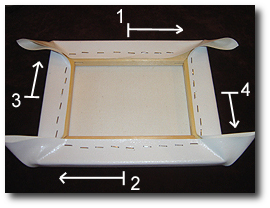
Now we are ready to pull and stretch the canvas for the remaining unsecured areas. Starting with the top (1) stretcher bar, PULL THE CANVAS SNUG, hold it with your thumb, and staple it from the center to the right stretcher bar as shown. Repeat this process for the bottom (2), left (3), and right (4) stretcher bars in that order.
IMPORTANT: You should notice that the canvas has more tension across the front face. It should not sag, droop, or have ripples along the surface. If these conditions exist, you must apply more pressure during pulling and stapling. If you determine that your canvas was not properly stretched, you may need to remove all the staples and repeat the stretching and stapling processes. Hearing the sound of a drum when you tap your finger on the back of the canvas indicates good tension. It may sound more like a resounding thud on a small hand-stretched canvas (as shown in this tutorial).
Canvas Stretching – Folding and Stapling Corners
Step 30
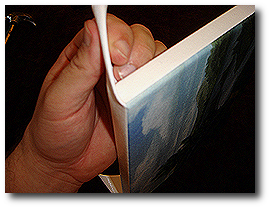
Now we must fold and secure the four corners. Hold the canvas material, as shown.
Step 31
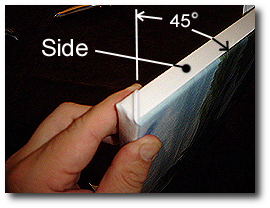
While applying pressure, wrap the corner around the stretcher bar as shown so that the fold is on the side of the assembly. The fold should run at a 45-degree angle, as shown.
Step 32
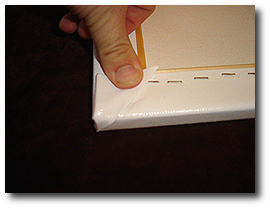
While applying pressure on the canvas material, fold it around the back face and hold it securely in the position shown in preparation for stapling.
Step 33

While holding the corner in position, insert several staples as shown.
Step 34
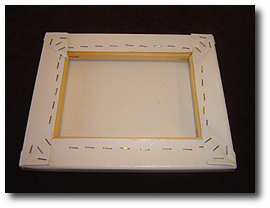
Repeat steps 30 through 33 on the remaining three corners. Be careful that your folded edges are always on along the side stretcher bars. Your finished assembly should look like this when viewed from the back. Now use your hammer to insert all staples fully.
Step 35

You have completed the 8×10 canvas stretching tutorial. Congratulations!
Concluding Thoughts
Please see our 16×20 Canvas Stretching Tutorial, a companion article to this 8×10 Canvas Stretching Tutorial, and learn about using canvas stretching pliers.
